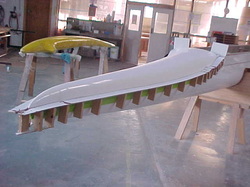
Composites, or now more correctly, Fibre composites, previously referred to as GRP (Glass fibre Reinforced Plastic) or FRP (Fibre Reinforced Plastic)) are polyester resins which have been strengthened with fibres. Fibreglass was another term commonly used to describe a Polyester resin reinforced using glass fibres. the newer term encompasses the Myriad of fibres now used other then glass, such as carbon, kevlar, PE, and even natural fibres.
Polyester resin is a liquid which when activated by a suitable catalyst (hardener) sets to a hard, rigid, tough form. When reinforced with glass fibre materials, its strength is increased considerably. Because it is a liquid it can be poured or injected into a mould, and once cured it will reproduce that shape. By selecting the right combination of resin and fibres, a product can be manufactured to meet the most demanding specifications, while still comparing favourably on a cost/performance basis with traditional materials.
Perhaps no other material offers more in the way of design flexibility than Fibre Composites. They can be used for thousands of applications ... from parts for engines to communication antennae, from seating to chemical pipelines, from architectural panels to boats and truck bodies.
With many advances in the design of fibre composites, our designers are constantly finding new and unique applications for this versatile material in industrial, military, commercial and consumer products.
Polyester resin is a liquid which when activated by a suitable catalyst (hardener) sets to a hard, rigid, tough form. When reinforced with glass fibre materials, its strength is increased considerably. Because it is a liquid it can be poured or injected into a mould, and once cured it will reproduce that shape. By selecting the right combination of resin and fibres, a product can be manufactured to meet the most demanding specifications, while still comparing favourably on a cost/performance basis with traditional materials.
Perhaps no other material offers more in the way of design flexibility than Fibre Composites. They can be used for thousands of applications ... from parts for engines to communication antennae, from seating to chemical pipelines, from architectural panels to boats and truck bodies.
With many advances in the design of fibre composites, our designers are constantly finding new and unique applications for this versatile material in industrial, military, commercial and consumer products.

